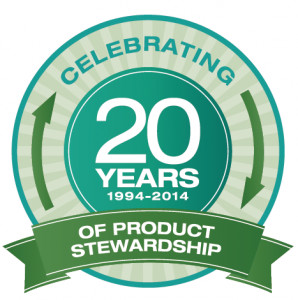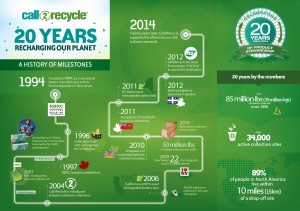To celebrate our 20th Anniversary, we will be featuring some short articles that takes a look back at key events in our history. Our first story focuses on the founding of the Rechargeable Battery Recycling Corporation (RBRC), now called Call2Recycle, Inc. in 1994. A series of events in U.S. history in the 1980s and early 1990s culminated in the formation of RBRC as a voluntary rechargeable battery recycling organization to meet new federal mandates.
Let’s Start at the Very Beginning
The roots of Call2Recycle date back to the early 1990s. Nickel Cadmium (Ni-Cd) batteries made up the bulk of rechargeable batteries, and were found in power tools, electronics, cellphones and toys. But it was also a time of change, especially in the area of hazardous waste.
In 1991, the Environmental Protection Agency (EPA) declared Ni-Cd rechargeable batteries as hazardous waste, but passed the regulatory responsibility to the states to develop their own policies for enforcement. States such as Connecticut, Minnesota, Maine and Vermont quickly passed state laws, but recycling efforts stalled in many other states because there was no deadline for implementation. Policies differed among the states, causing confusion for manufacturers.
The big five US battery makers of the time formed the Portable Rechargeable Battery Association (PRBA) in 1991 to look at ways to collect and dispose of Ni-Cd batteries on a national basis. PRBA invited manufacturers that used rechargeable batteries in their products to join their efforts. One of their first goals was to pave the way for a national program.
PRBA’s first efforts focused on convincing the EPA to add a Ni-Cd battery specific mandate to the Universal Waste Rule in 1991. This rule codified the collection, packaging and disposal of hazardous waste; defined the requirements for “hazardous waste approved” facilities; and redefined acceptable transportation methods for moving waste across state borders. This law was critical to opening the door to a national rechargeable battery collection program because it allowed for the transportation of batteries across state lines to processing facilities. Four long years later, the law was finally passed.
Why the urgency to develop a national recycling program? Simply, to manage liability. Hazardous waste was a hot topic at the time. The Love Canal eco-disaster (where a large petroleum corporation buried 21,000 tons of toxic waste which was later turned into a disastrous housing development) had amplified the need for strict federal regulations governing hazardous waste. The severe penalties and clean-up costs were a huge deterrent to manufacturers generating anything classified as hazardous waste and violating recycling regulations. PRBA’s efforts to develop a national rechargeable battery recycling program enabled companies to avoid this liability. Manufacturers jumped on the bandwagon.
Amidst these regulatory changes, PRBA recognized that a separate program was needed to handle the daily operation of a national collection program. The Rechargeable Battery Recycling Corporation (RBRC) was launched on March 21, 1994, to coordinate a rechargeable battery recycling program among licensees, retailers, businesses, public agencies and consumers. PRBA continued as the public advocate on national policy development.
Next Month: April – Adapting to Change. A look at the 1996 Battery Act in the U.S. – the fulfillment of a dream. In the meantime, find us on social media for the answer to this question:
Who were the five original founding companies of RBRC?
- Gates Batteries (now Energizer), Saft, Panasonic, Varta and Sanyo
- RadioShack, Panasonic, Sony, Sanyo, Saft
- The Home Depot, RadioShack, Sony, Varta, Milwaukee Tools
For the answer, check FaceBook and Twitter.
ShareMAR

